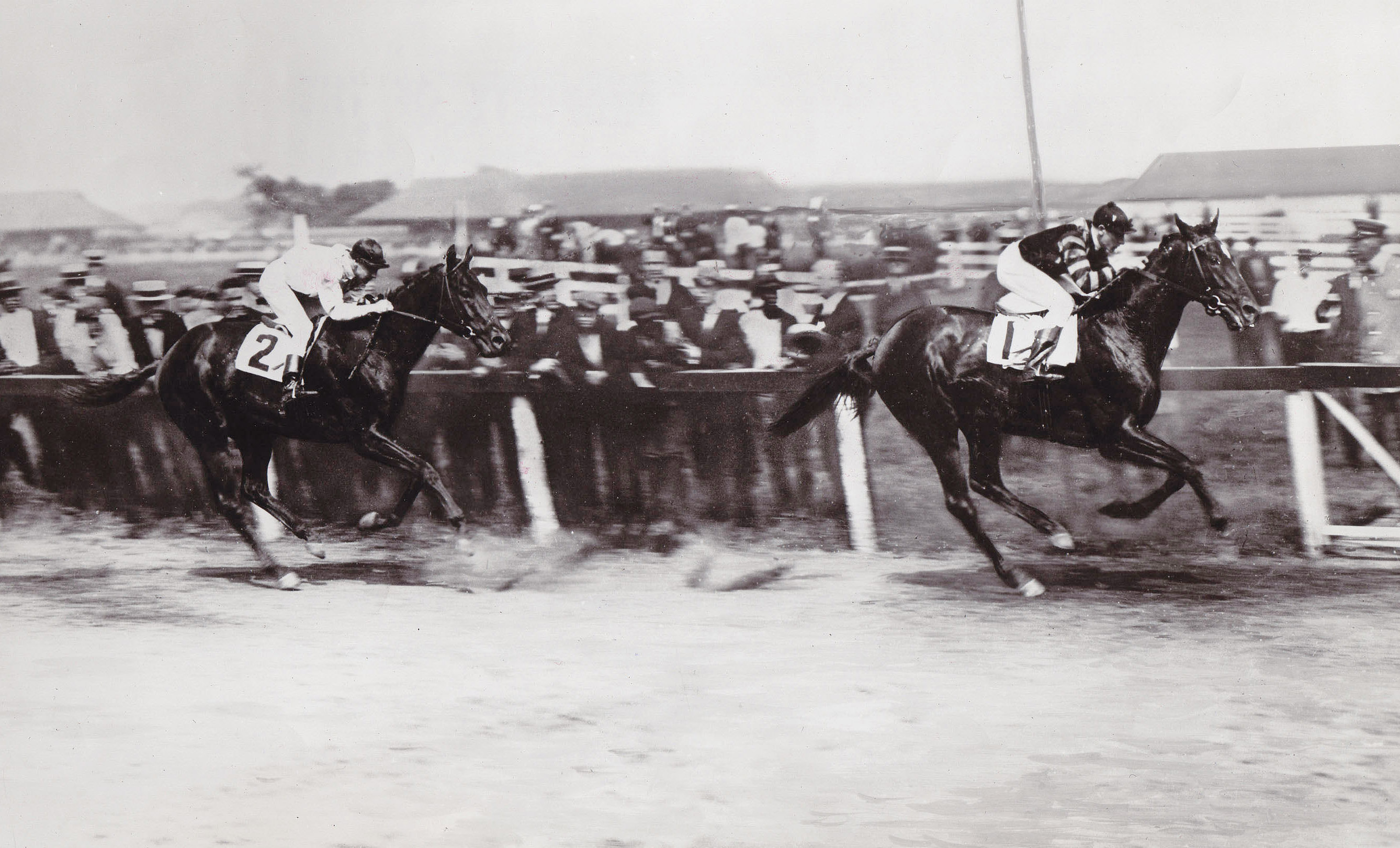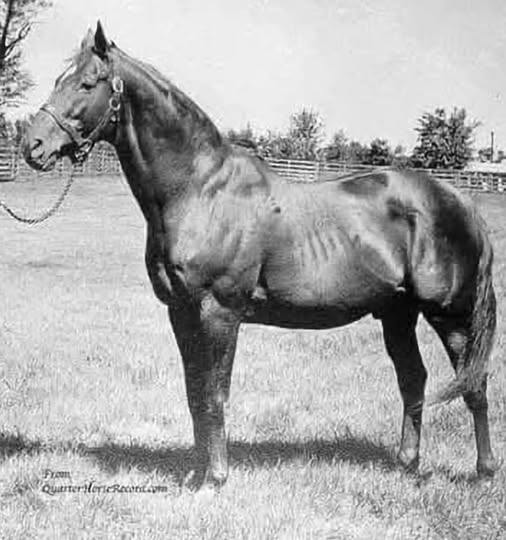A Story That Begins With a Storm of Power and Possibility
There are racehorses whose names fade with time, remembered only in old programs or dusty photographs. And then there are legends—horses whose presence still seems to gallop across history.
In the early twentieth century, one such legend emerged, a bright flame of speed and spirit who captured the imagination of anyone who stood close enough to hear the thunder of his stride.
His name was Man O’ War, a towering chestnut colt whose remarkable talent would not only elevate the world of racing, but also become the subject of books, folklore, and enduring admiration.
Writers, trainers, jockeys, and fans all tried to describe what they witnessed when Man O’ War ran, yet even words seemed too small for him. As journalist W. O. McGeehan wrote in 1927, the colt carried himself with a rare combination of athletic ability and a spirit that ignited when challenges grew tougher.
This is the story of how Man O’ War became more than a racehorse—how he evolved into an American icon whose influence remains visible today.

The Birth of a Champion
A Remarkable Beginning
Man O’ War was foaled in 1917 at the renowned Nursery Stud in Kentucky. Even as a young colt, his frame stood out. Tall, powerful, and full of energy, he showed a deep chest, long stride, and an eagerness to charge forward that trainers recognized as the foundation of greatness.
He was purchased as a yearling by Samuel Riddle, who entrusted him to trainer Louis Feustel. Both men quickly realized they were not preparing a typical racehorse. They were looking after an athlete who seemed destined to push every boundary of the sport.
A Personality Larger Than Life
Those who worked with Man O’ War described him as intelligent, energetic, and confident. He responded strongly to routine, recognized familiar voices, and seemed to know exactly when a race was approaching. His bold nature made him both impressive and challenging, but never unmanageable.
Even today, equine behaviorists suggest that horses with naturally expressive personalities often show exceptional athletic performance. Some believe Man O’ War’s fiery spirit was a sign of heightened awareness and a strong drive to run—qualities often seen in elite equine athletes.

Rising to Greatness on the Track
A Racing Style That Captivated the Nation
As a two-year-old, Man O’ War announced himself with performances that were fast, powerful, and consistently dominant. His stride was long but controlled, his acceleration smooth, and his focus unwavering.
Crowds soon realized that watching Man O’ War race was an experience unlike any other. He moved with the confidence of a horse who understood his own strength.
By the time he entered his three-year-old season, he was no longer just winning races. He was redefining what spectators believed a racehorse could achieve.
The Weight He Carried, the Odds He Defied
Many of Man O’ War’s most memorable victories came when he was assigned unusually heavy weights to carry—sometimes more than any other horse in the race.
In early twentieth-century racing, weight assignments were used to level the field, giving stronger horses additional weight to balance competitions. Man O’ War often carried the heaviest load, yet he continued to perform at exceptional levels.
Historically, sportswriters noted that the conditions never seemed to trouble him. In bright sun or light rain, in crowded fields or small ones, he ran with the same confidence. McGeehan famously described him as a horse who rose higher when the odds grew longer—suggesting that Man O’ War possessed a rare competitive instinct.
Today, scientists studying equine biomechanics and performance note that some horses have muscle structure and cardiovascular capacity that allow them to perform efficiently even under increased physical demand. Genetic diversity, training consistency, and overall temperament can all contribute to such resilience.
A Rivalry That Remains Part of Racing Lore
No horse, no matter how talented, competes alone. Man O’ War met skilled challengers throughout his career, each race adding to his reputation. Observers often remarked that competitors performed at their highest level against him, as though the presence of such a powerful athlete brought out the best in everyone.
McGeehan’s quote reflects this history, noting that Man O’ War seemed to shine brightest when situations became uncertain or when races required quick decisions and strong surges at critical moments.
Beyond the Track: How a Racehorse Became a Cultural Icon
Man O’ War in American Folklore
As his fame grew, Man O’ War became part of American storytelling. Newspapers chronicled his races in vivid detail, artists painted his image, and fans traveled long distances for the chance to see him in person.
By the time he retired, he represented more than racing excellence. He represented the optimism and resilience of an era.
In communities across the country, families spoke of him as though he were a hero from mythology rather than a living athlete. His bold chestnut coat, determined expression, and sweeping stride became symbols of beauty and power.
Cultural historians note that heroes who embody strength, speed, and grace often become larger than life. Much like legendary horses of ancient myths—from Pegasus in Greek lore to the Wind Horse in Tibetan tradition—Man O’ War inspired stories that carried deep emotional resonance.
A Legacy That Influenced Generations
Man O’ War’s impact extended far beyond his own career. As a breeding stallion, he passed on traits that shaped multiple generations of racehorses. His descendants include champions and notable sires, creating a lineage that remains important in modern racing.
Even today, visitors to the Kentucky Horse Park—where he is honored—describe a sense of connection to a past era of athletic achievement. His presence continues to inspire discussions about horse care, responsibility, and the extraordinary potential within the equine world.

Scientific Perspectives on Why Man O’ War Was Great
The Anatomy of an Exceptional Athlete
Modern equine science helps explain some of Man O’ War’s remarkable qualities. While researchers cannot analyze him directly, historical measurements and photographs offer insight.
Experts point to several likely advantages:
- A deep chest cavity, suggesting strong cardiovascular capacity
- Well-defined muscling along the shoulder and hindquarters
- Naturally extended stride length
- Keen responsiveness to training cues
- Balanced skeletal structure that supported efficient movement
These characteristics are commonly associated with high-performance Thoroughbreds.
The Role of Temperament and Training
Man O’ War’s spirited personality may have played a central role in his success. Studies show that horses with bold, engaged temperaments often adapt quickly to complex training.
Trainer Louis Feustel maintained a steady routine, focusing on controlled exercise, consistent handling, and gradual confidence building. Combined with Samuel Riddle’s thoughtful management, this created an environment in which Man O’ War could flourish.
Myth, Reality, and the Making of a Legend
When Storytelling Meets History
Over the decades, stories about Man O’ War have grown into a mixture of fact, admiration, and folklore. Some tales emphasize his almost mythical talent; others highlight his spirited presence.
While not every dramatic account can be confirmed, these stories reflect how strongly he influenced spectators and storytellers.
This blend of history and mythology is common around the world. Horses have long inspired legends because they combine beauty, speed, and personality in a way few animals do. Man O’ War simply stepped into that timeless tradition.

Conclusion: Why Man O’ War Still Captivates Us Today
Man O’ War’s story continues to resonate because it embodies many things people admire: natural talent, determination, partnership, and a kind of majestic presence that feels both real and extraordinary.
His performances inspired awe, his personality fascinated experts, and his legacy challenged future generations to consider not only the thrill of competition, but the responsibility that comes with caring for extraordinary animals.
At its heart, his story invites us to reflect on the powerful connection between humans and horses—a bond shaped by curiosity, admiration, and the timeless desire to understand greatness.
It is this sense of wonder that keeps his legend alive and reminds us that some stories, like some horses, continue to run far beyond the finish line
